Italian Gothic horror on Blu-ray
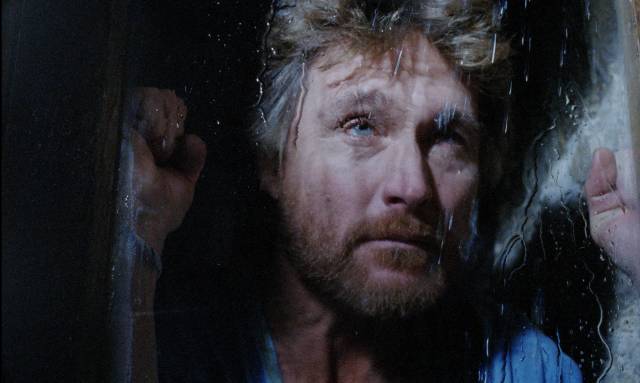
Although I like many movies, I don’t like them all in the same way or for the same reasons. I might like something, flaws and all, simply because it was made by a particular filmmaker. I might like something because of its content regardless of who made it. I might enjoy something simply because of its genre, regardless of quality. And there are classes of movies I like because of a combination of factors – where and when they were made, with who made them as a secondary yet sometimes important consideration. I love horror and sci-fi B-movies from the ’50s and paranoid thrillers from the ’70s. I also really like a whole range of Italian genre movies from the ’60s and ’70s, which I got into through several different channels – spaghetti westerns, beginning with Leone and expanding from there; gialli, starting with Argento, then working backwards to Bava, who in turn opened other doors.
One of those doors led me belatedly to poliziotteschi when I discovered Rabid Dogs twenty-odd years ago; another had first introduced me to the Italian Gothic when I saw Kill, Baby … Kill! on late-night TV in the mid-’70s. Although Bava’s contributions to the Gothic spanned from Black Sunday (1960) to Lisa and the Devil (1974), the genre flourished only briefly, already being supplanted by contemporary thrillers in the mid-’60s and mostly absorbed into the giallo by the early ’70s. The very nature of Italian exploitation caused genres to erupt and burn out quickly, but in the few core years of any particular genre, production tended to be prolific, which resulted in turn in a lot of repetition and self-cannibalizing along with flashes of innovation.
I’ve recently been dipping into the Italian Gothic once more thanks to new releases from Arrow and Vinegar Syndrome. Arrow’s box set contains four movies, two in period, the other two with contemporary settings, while the VS release is a very late addition to the genre, with a contemporary setting and very perverse plot elements.
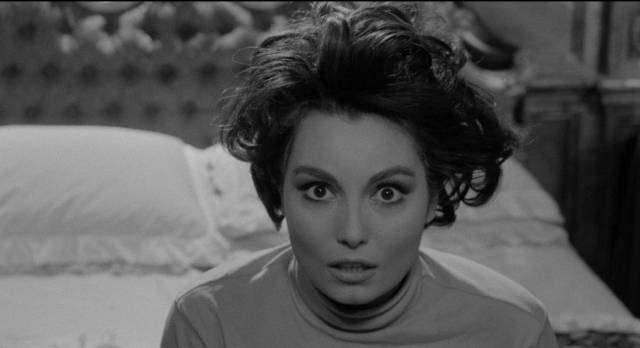
Gothic Fantastico: Four Italian Tales of Terror (1963-66)
The Gothic has its roots in the art and literature of the late 18th Century and early 19th Century, a gloomy and sensational response to the rationality of the Enlightenment. It’s domain was often brooding castles and derelict churches haunted by tortured revenants and madmen. The genre’s horrors were frequently rooted in suppressed family histories and afforded a salacious exploration of sex, perversion and a rejection of conventional morality and religion. Although society had long since moved on from many of the factors which gave rise to the Gothic, the tropes still provided, even in the mid-20th Century, a vehicle for commercially exploitable sensation – while clothed in moralistic tut-tutting, filmmakers could offer audiences madness, murder and, most profitably, sex, all safely distanced in costume dramas and remote locales. Even when situated in a contemporary context, stories were more often than not provided with distance by isolating characters in remote estates and decaying mansions in which the past overshadowed the present. In the Gothic, everything is imbued with an unwholesome atmosphere which undermines the modern and the rational.
All four films in the Arrow set were made at the height of the Italian iteration of the genre, shot in widescreen black-and-white, which itself seems like a genre trope – no doubt budget considerations played a part, but by the mid-’60s colour was becoming standard, so the use of black-and-white was at least partially a deliberate choice for these Gothic movies. Three of the directors are not generally associated with the genre, while the fourth, having made three Gothics in a row in a single year, moved on to other things because he didn’t want to be pigeonholed.
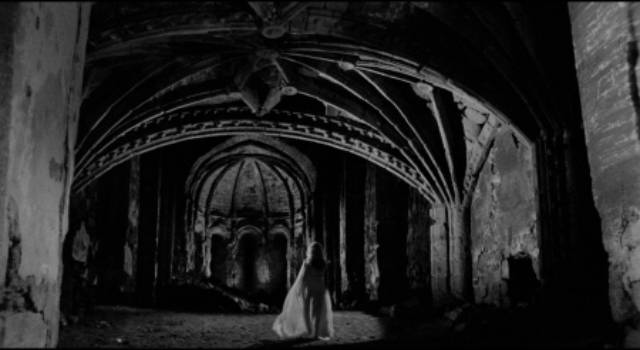
The Blancheville Monster (Alberto De Martino, 1963)
The Blancheville Monster, also known bluntly as Horror (1963), came early in the career of Alberto De Martino, known to me for his two ’70s post-Exorcist horror movies The Antichrist (1974) and Holocaust 2000 aka The Chosen (1977). The period setting (supposedly in Ireland) along with some obvious Poe references indicate the influence of Roger Corman’s Poe adaptations made during the previous few years. The opening sequence, with its approach through barren woods to a bleak mansion, sets a tone filtered through memories of Corman’s House of Usher (1960).
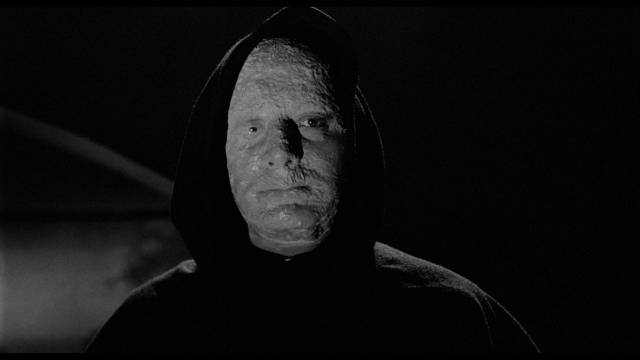
Emilie De Blancheville (Ombretta Colli) returns home with her friends Alice (Iran Eory) and John (Vanni Materassi) only to be told that her father is dead. Emilie’s brother Roderic (Gerard Tichy) is gloomily obsessed with a centuries-old family curse which predicts Emilie’s death before her upcoming twenty-first birthday. There are ominous portents, including Alice’s discovery that the supposedly dead father is hidden in a tower room, horribly disfigured by burns. New housekeeper Miss Eleonore (Helga Liné) may or may not be poisoning Emilie, who wanders at night and is pursued into nearby ruins by her disfigured father, who has escaped confinement.
Everything is overwrought, with characters endlessly exchanging ominous looks; there are suggestions of unwholesome incestuous feelings between Roderic and Emilie – and for good measure, a premature burial leads to the story’s resolution. The climactic revelation, already suggested by his name, that Roderic is mad and engineering the fulfillment of the prophecy isn’t too surprising. It may not be subtle, but De Martino generates a lot of atmosphere and keeps things moving quickly enough to skim over the implausible plot contrivances.
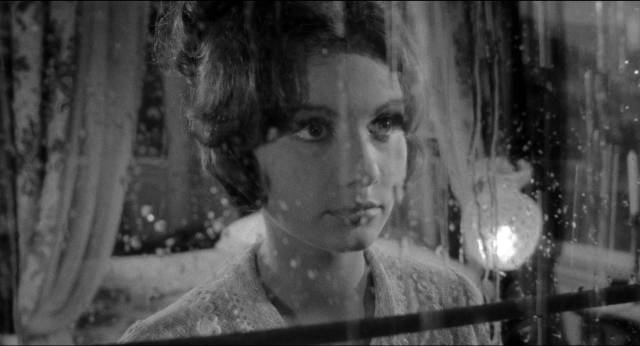
Lady Morgan’s Vengeance (Massimo Pupillo, 1965)
Lady Morgan’s Vengeance (1965) was Massimo Pupillo’s third Gothic in a row, all made within a single year. Although the least well-known – probably because the first, Terror-Creatures from the Grave, starred Barbara Steele, and the second, Bloody Pit of Horror, is famous for its camp absurdities – it’s actually the most interesting of the three. Lady Susan Blackhouse (Barbara Nelli) has fallen in love with architect Pierre Brissac (Michel Forain), who has been renovating the family estate in England, something which is a problem for Sir Harold Morgan (Paul Muller), an older man who has known her since childhood and expects to marry her and gain her estate. When Pierre sets sail for the continent, a shadowy figure pushes him overboard, and the devastated Susan submits and marries Sir Harold after all.
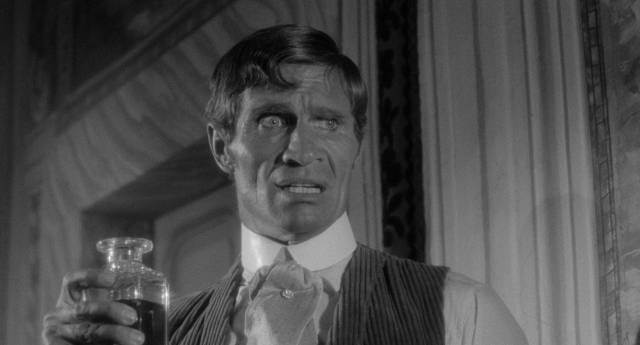
The aristocrat doesn’t make much effort to conceal his nefarious intentions; he brings his mistress, Lillian (Erica Blanc), into the house as the new housekeeper and when Susan’s uncle Sir Neville (Carlo Kechler) shows up, he’s imprisoned in the cellar where Sir Harold’s servant Roger (Gordon Mitchell) sadistically whips him for fun. Lillian exerts a kind of hypnotic power over Susan, whispering suggestions to her at night, which cause her to sleepwalk … and halfway through the movie she climbs to the ramparts and falls to her death. This is an unexpected turn of events, compounded by the discovery that Pierre had survived but lies in hospital with amnesia. At the moment of her death, a psychic shock restores his memory and he returns to England and the estate.
The second half of the film, in which he reconnects with the ghost of Susan, reveals how she got her revenge after death by playing the three conspirators against one another, sowing distrust between Sir Harold and Roger over Lillian. Having achieved her aims and having reconnected with Pierre, she can finally rest in peace, with Pierre left to mourn his lost love as he leaves the estate to its tormented trio of ghosts who remain trapped by their own evil actions.
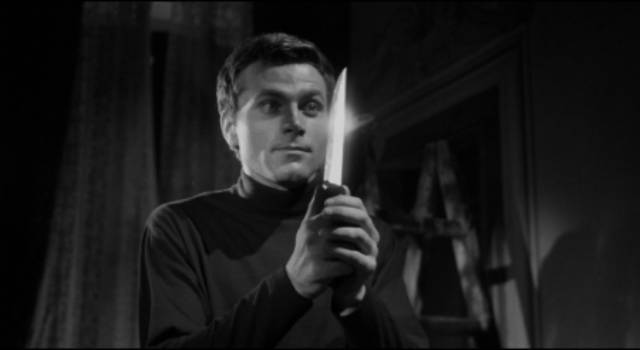
The Third Eye (Mino Guerrini, 1966)
Although Gothic in tone and visual style, Mino Guerrini’s The Third Eye (1966) is set in the present. I had an odd sense of deja vu as I watched and was well into the movie before it finally dawned on me that I’d seen this story before, though not in this particular iteration; this was remade, much more luridly, thirteen years later by Joe D’Amato as Buio Omega, aka Beyond the Darkness (1979).
It’s already apparent in the opening moments that there’s something not quite right between Mino Alberti (Franco Nero) and his fiancee Laura (Erika Blanc); Laura seems rather childlike (skipping through meadows and picking wildflowers) while Mino waits impatiently in front of his mother’s mansion. The source of the tension becomes clear when we see that his mother (Olga Solbelli) is hostile to Laura because she’s about to take Mino away – there’s an unhealthy bond between mother and son and Mino is not strong enough to assert himself against the old woman.
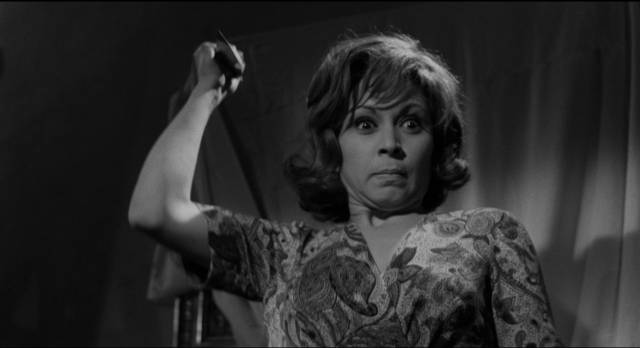
The situation is further complicated by the fact that family servant Marta (Gioia Pascal), who grew up in the household and is in love with Mino, is more than willing to act on mother’s animosity by sabotaging the brakes on Laura’s car. Laura drives away after an argument with Mino, and he follows her only to see her lose control and plunge off a cliff. While that is happening, Marta inadvertently pushes mother down the stairs, so Mino loses both of the women in his life on the same day, propelling his neurosis into full-blown psychosis. He brings women home but can only have sex by concentrating on the preserved body of Laura, which is lying within sight, and strangling the woman to achieve a climax.
Although less explicit than D’Amato’s version, The Third Eye is unabashedly perverse with its intimations of incest and necrophilia. While a very young Franco Nero, who was about to achieve stardom with the release of Sergio Corbucci’s Django a couple of months after this, doesn’t seem entirely comfortable as Mino, and Erika Blanc isn’t around for long, Gioia Pascal makes a strong impression as Marta – strangely, she seems to have only one other credit, a minor role in a comedy the previous year.
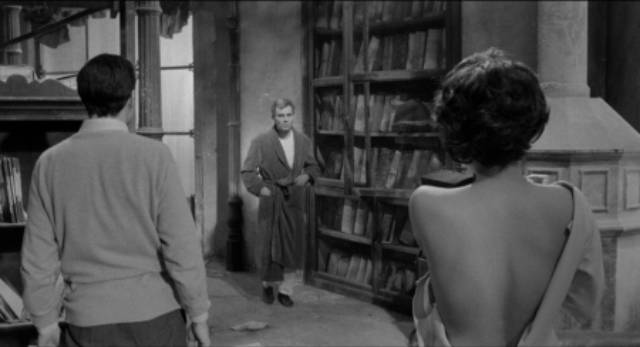
The Witch (Damiano Damiani, 1966)
Damiano Damiani is best known for pointedly political movies like the western A Bullet for the General (1967) and crime films like Mafia (1968), The Most Beautiful Wife (1970) and How to Kill a Judge (1975), so the slightly surreal, supernaturally-inflected The Witch (1966) seems a little out of character. Strange and atmospheric, it’s a fascinating study in the clash between arrogant masculinity and female sexuality, though the ending seems surprisingly regressive for a filmmaker whose other work frequently embodies progressive ideas.
English actor Richard Johnson – showing up between appearances as a Victorian officer in Basil Dearden’s Khartoum (1966) and as British spy Bulldog Drummond in Ralph Thomas’s Deadlier Than the Male (1967) – is author Sergio Logan, a rather arrogant and self-centred man whom we immediately see is not particularly committed to his current relationship. His attention is on an older woman he keeps catching sight of, getting the feeling that she is following and watching him. He begins to pursue her, eventually asking a man at a news kiosk what this woman had been looking at – and discovering a personal ad seeking someone for a job whose qualifications seem to describe him exactly.
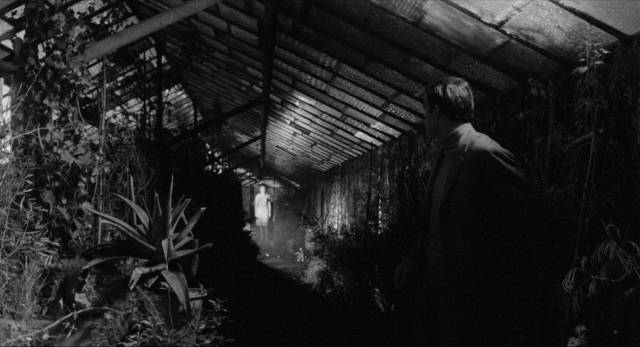
This leads him to a vast, decaying palazzo inhabited by the older woman, Consuelo Lorente (Sarah Ferrati), who had placed the ad in order to find someone to organize her dead husband’s neglected library and edit his journals, which are apparently a record of his erotic experiences. Logan is both interested and repelled – the job would require him to move in, but there’s something obviously peculiar about the situation, not least since it appears that the widow had tailored the want ad specifically to target him. In response to his reluctance, the widow drinks some herbal concoction and immediately collapses. He calls a doctor acquaintance, believing she’s poisoned herself, and while he waits a younger woman emerges from the shadows of the library.
This is Aura (Rosanna Schiaffino), the widow’s “daughter”. Logan is immediately entranced, his resistance crumbling, even though he soon encounters his predecessor, Fabrizio (Gian Maria Volontè), a haunted figure lurking in the library like a used-up husk. It gradually becomes clear that the widow is an ageless creature who can transform herself into the alluring Aura to ensnare men whose spiritual energy she then consumes to perpetuate her own existence.
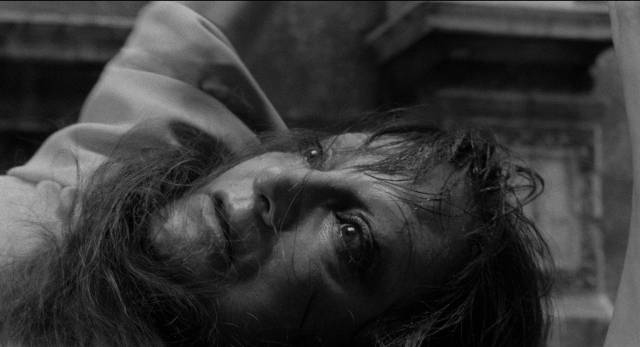
The image of men presented here is not flattering, unable to manage their own libido and rendered vulnerable to the seductive power of a timeless female principle, but the satirical element turns dark towards the end when the film comes to express rather than critique the pathology which fuelled the witch craze of the Middle Ages, a sickness whereby men project their own weakness onto a phantom of malevolent female power which has to be violently repressed. I confess that, while I was captivated by the film and its vision of gender conflict rooted in a long history which is reaching a terminal state of collapse, the ending in which Logan burns the old woman to death on a pyre, modern man reverting to Medieval cruelty, left a sour taste.
*
All four films were restored in 2K from the original negatives, and they all look excellent in nicely textured black-and-white. Each film gets a commentary (from Paul Anthony Nelson, Alexandra Heller-Nicholas, Rachel Nisbet and Kat Ellinger respectively) and a brief introduction from Mark Thompson Ashworth, as well as a video essay and one or two interview featurettes. This is another pleasing set from Arrow illuminating a genre niche which probably holds enough as yet undiscovered titles to make more sets possible.
*
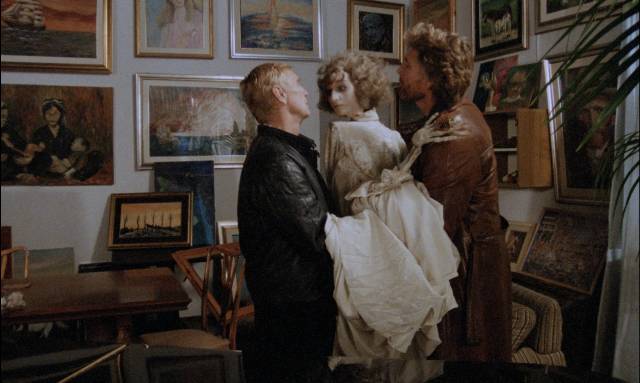
Blood Delirium (Sergio Bergonzelli, 1988)
Made a couple of decades later, after years of more graphically violent movies, Sergio Bergonzelli’s Blood Delirium (1988) seems like a trashy throwback, drawing more on the Gothic than the giallo, but bringing giallo’s gaudy visuals and violence to bear on its story of an artist driven mad by the death of his wife and muse, who turns to murder to revive his creative impulse.
Earlier in his career, Bergonzelli had made In the Folds of the Flesh (1970), released just a few months after Dario Argento’s The Bird With the Crystal Plumage, but before that landmark had cemented the giallo “rules” – Bergonzelli’s movie had murders, dark family secrets and even an uncomfortable element of Nazisploitation, wrapped up in a feverishly perverse, hallucinatory package. After almost two decades devoted mostly to sex, crime and comedy, Bergonzelli returned to that type of story, even more graphic and extreme (but without the Nazis), in Blood Delirium.
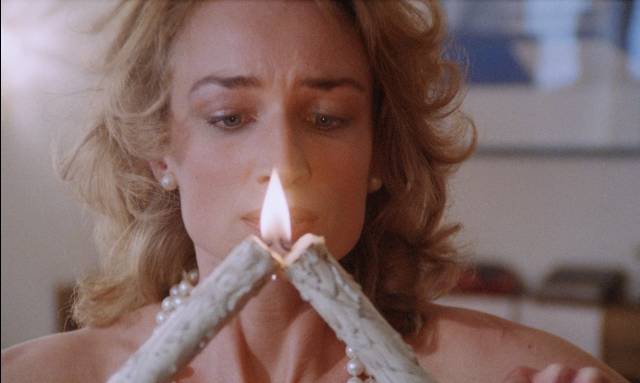
Unusually for the time, the movie establishes a supernatural element right at the start. Famous concert pianist Sybille (Brigitte Christensen), having gratuitously stripped to her underwear, is preparing dinner for her boyfriend when some force blows through her apartment and a voice gives a cryptic warning – a voice which seems to be herself but from the future. Meanwhile, famous artist Saint Simon (John Phillip Law) is in despair as his beloved wife (also Christensen) lies dying. She’s the inspiration for his work (well, her and his belief that he’s Vincent Van Gogh reincarnated), so when she dies, he can no longer create.
You know you’re in for the unexpected when the artist plays his dead wife’s favourite piece on the piano as she lies in the living room before burial and faithful servant Hermann (Gordon Mitchell, two decades after playing another malevolent servant in Lady Morgan’s Revenge) begins molesting the corpse. Finally noticing, Saint Simon berates Hermann, but doesn’t seem all that much put out. A year later, still tormented, Saint Simon and Hermann break open the tomb and retrieve the now-skeletal remains (crawling with maggots), dressing the bones and placing a mask over the skull, and sitting the remnants at the piano. But having his wife back in this condition doesn’t revive the artist’s inspiration – in fact, he hears her mocking him.
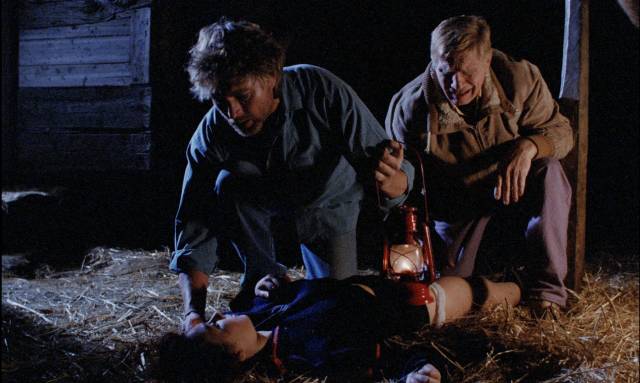
Meanwhile, that spectral wind revisits Sybille, bringing a flyer announcing a Saint Simon gallery show. Drawn irresistibly, she discovers paintings which look uncannily like herself and Saint Simon immediately sees her as his wife reincarnated. He invites her to visit his castle and, although there’s obviously something a bit creepy about him, she accepts. Along the way, strangely menacing spectral lights manifest, but she ends up at the castle anyway where it seems clear that the artist (and Hermann) are prepared to keep her as a substitute for the absent wife.
After a few odd events – and witnessing Hermann attempt to rape a local woman – Sybille tries to leave, but ends up essentially a prisoner, drugged and delirious. As she lies unconscious, Hermann acts out his necrophile fantasy by raping her inert body. He also attempts to rape another local woman in the stable and inadvertently kills her when she resists. Finding him over the body, Saint Simon is struck by the colour of her blood and realizes what’s been missing from his art – taking the body back to his studio, he drains it and gets to work. When the blood runs out, he and Hermann have to find new sources…
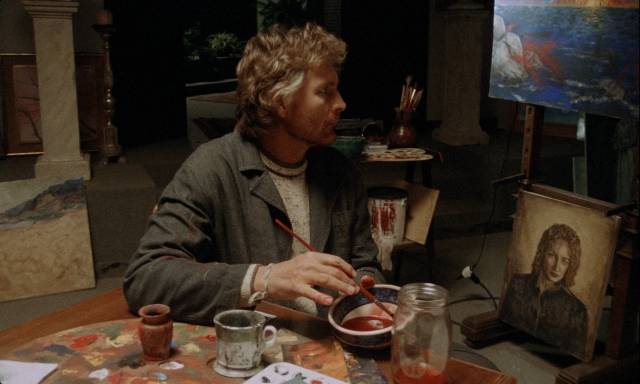
Things get even more demented, with Saint Simon plunging into full-on bug-eyed madness and Sybille’s boyfriend arriving in a helicopter to save the day. But it’s the dead wife’s spirit which finally puts an end to Saint Simon and Hermann, bringing the studio crashing down around them.
Garish, absurd and unabashedly wallowing in its sordid exploitation tropes, Bergonzelli’s movie is perhaps most notable for the presence of John Phillip Law as the mad artist, two-thirds of the way through a fifty year career whose early high points included Norman Jewison’s The Russians Are Coming, the Russians Are Coming (1966), Mario Bava’s Danger: Diabolik, Roger Vadim’s Barbarella and John Flynn’s The Sergeant (all 1968), not to mention Otto Preminger’s eccentric late works Hurry Sundown (1967) and Skidoo (1968 again!). While those early movies traded in his distinctive good looks, which having reached middle age had become craggier, he appears to relish the melodramatic excesses the role of Saint Simon called for.
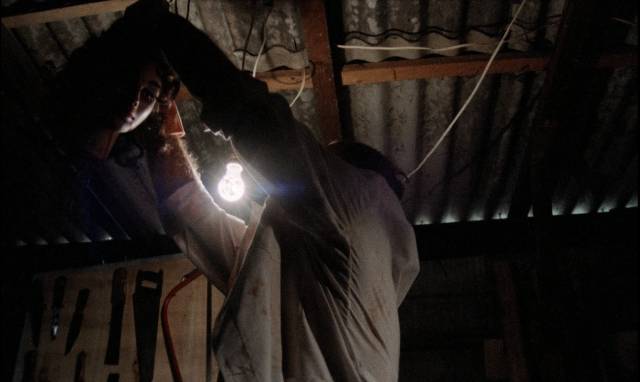
Also surprising is former sword-and-sandal star and perennial genre presence Gordon Mitchell, doing particularly sordid things towards the end of a long career which began with bit parts in Hollywood (The Ten Commandments, The Young Lions, Rio Bravo, Spartacus) before he headed for Italy and a kind of stardom. Watching the former Maciste cutting up bodies and occasionally chewing on a slice could be considered a low point, but like Law, Mitchell appears to be enjoying himself.
Vinegar Syndrome’s 2K scan from the original negative is probably as good as it can be for a movie of this type – a bit grainy, occasionally vibrant, but generally a little flat. There’s a commentary on the Blu-ray from Troy Howarth and Eugenio Ercolani and several interviews with cast and crew members.
Comments